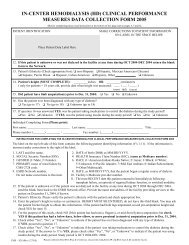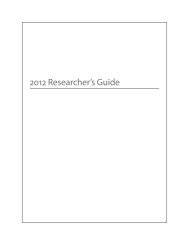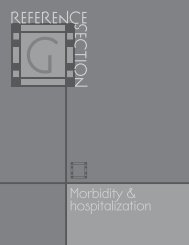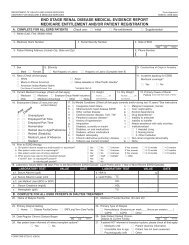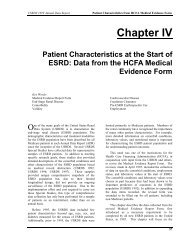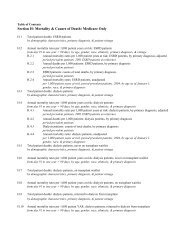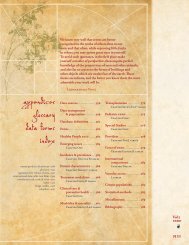Download - United States Renal Data System
Download - United States Renal Data System
Download - United States Renal Data System
Create successful ePaper yourself
Turn your PDF publications into a flip-book with our unique Google optimized e-Paper software.
hospitalization is censored only at death or December 31 of<br />
the year; modality change is not used as a censoring event. For<br />
transplant patients in the all-ESRD and transplant categories,<br />
the analysis period is censored at the earliest of death, three<br />
years following the transplant date, or December 31 of the year.<br />
The censoring of transplant patients at three years following<br />
the date of transplant is necessary because Medicare eligibility<br />
may be lost and hospitalization data may be incomplete for<br />
these patients.<br />
In the case of a hospitalization that begins before January<br />
1 or day 91 of ESRD and continues into the analysis year, the<br />
time at risk for first admission begins the day of discharge from<br />
this bridge hospitalization. Patients with bridge hospitalizations<br />
that span the entire analysis period are excluded from<br />
the first admission rates.<br />
Time at risk is calculated differently for length of stay and<br />
for total admissions. Because a hospitalized patient remains at<br />
risk for additional days in the hospital, rates for hospital days<br />
include hospital days in the time at risk. But because this currently<br />
hospitalized patient is not, however, at risk for additional<br />
admissions, hospital days for each year are subtracted from the<br />
time at risk for total admissions. In the case of hospitalizations<br />
in which admission occurs the same day as discharge, zero days<br />
are subtracted from the time at risk for total admissions. When<br />
bridge hospitalizations span the start of the analysis period,<br />
only the days within the period are subtracted from the time<br />
at risk for total admissions.<br />
All admissions and hospital stay days that occur during the<br />
analysis period are included, respectively, in the total admissions<br />
and length of stay for each year. Admission for a hospitalization<br />
that occurs before and spans the start of the analysis<br />
period is excluded from the total admissions for that analysis<br />
period, and only the hospitalization days within the period are<br />
counted in the total days for length of stay rates. The minimum<br />
length of stay is one day; hospitalizations with admission and<br />
discharge on the same day and thosewith discharge the day<br />
after admission are counted as one day.<br />
Cause-specific Unadjusted Rates per Patient-<br />
Year<br />
Cause-specific hospitalization rates may be computed by<br />
counting only hospitalizations with selected principal ICD-<br />
9-CM diagnosis codes. In the denominator of the rate, the<br />
time at risk is computed similarly as described above for total<br />
admission rates. However, in the numerator, only hospitalizations<br />
with specified principal diagnosis codes are counted in<br />
the total cause-specific admissions. For example, principal<br />
ICD-9-CM diagnosis codes of 480-486 and 487.0 can be<br />
used for pneumonia.<br />
Unadjusted Rates per Patient<br />
Rates of hospital days and total admissions may also be calculated<br />
per patient. For a selected year, the numerator remains<br />
the total number of events, and the denominator is the total<br />
number of period prevalent patients for the year. Rates per<br />
patient are susceptible to bias because they do not consider<br />
the actual length of time that a patient is at risk during the<br />
year. For example, a greater number of patients at risk for only<br />
a fraction of the year may produce smaller rates.<br />
Section 7 · Survival and Mortality<br />
Survival and mortality analyses are often used to compare<br />
outcomes among treatment modalities, age groups, or<br />
races, or to evaluate outcome trends over time. Results can<br />
be reported for both incident and prevalent cohorts for the<br />
following groups: all-ESRD patients, all dialysis patients,<br />
all hemodialysis patients, all peritoneal dialysis patients, all<br />
transplant patients, or all ESRD patients aged 65 years and<br />
over. Primary analyses include unadjusted survival probabilities<br />
using the Kaplan-Meier method, adjusted survival<br />
probabilities using the Cox regression model, unadjusted<br />
death rates by cause of death, adjusted death rates, and adjusted<br />
interval death rates.<br />
<strong>Data</strong> Sources<br />
These survival and mortality analyses require patient demographic<br />
information such as age, gender, race, primary cause<br />
of ESRD, death date, and cause of death, and treatment modality<br />
history data, which can be obtained from the USRDS<br />
Core CD files PATIENTS and RXHIST or RXHIST60.<br />
Unadjusted First-year Survival Probabilities:<br />
Incident Patients<br />
First-year survival probability is the probability of surviving<br />
from day 91 after onset of ESRD to one year plus 90 days<br />
(days 91 to 455). This 90-day delay is necessary because<br />
many patients aged younger than 65 years do not become<br />
eligible for Medicare for up to 90 days, and their data may<br />
be incomplete for this period. The survival probability can<br />
be estimated for patient characteristics including age on the<br />
first ESRD service date, race, gender, and primary cause of<br />
ESRD. Age, race, and primary cause of ESRD can be broken<br />
down into groups as needed. The Kaplan-Meier method for<br />
calculating the unadjusted first-year survival probability is<br />
described in Appendix C, Statistical Methods, page 55.<br />
Adjusted First-year Survival Probabilities:<br />
Incident Patients<br />
The adjusted first-year survival probability from day 91 can<br />
be estimated using the Cox regression model, and can be<br />
calculated for patient characteristics including age on the first<br />
ESRD service date, race, gender, and primary cause of ESRD.<br />
Age, race, and primary cause of ESRD can be broken down<br />
into groups as needed. To avoid excessive imprecision of the<br />
estimated survival probabilities due to small cell sizes, these<br />
probabilities can be calculated using aggregate categories for<br />
age, gender, race, and primary cause of ESRD, with a probability<br />
calculated for groups defined by one of these variables<br />
adjusted for the remaining three. Overall probabilities for<br />
all patients can be adjusted for each of the four variables.<br />
The Cox regression model for calculating adjusted first-year<br />
survival probability is described in Appendix C, Statistical<br />
Methods, page 55.<br />
Adjusted First-year Death Rates: Incident<br />
Hemodialysis Cohorts<br />
Adjusted first-year death rates for incident cohorts can be<br />
estimated using a Cox model. These death rates are presented<br />
using aggregate categories for age, gender, race, and primary<br />
30 e Sections 1-9




